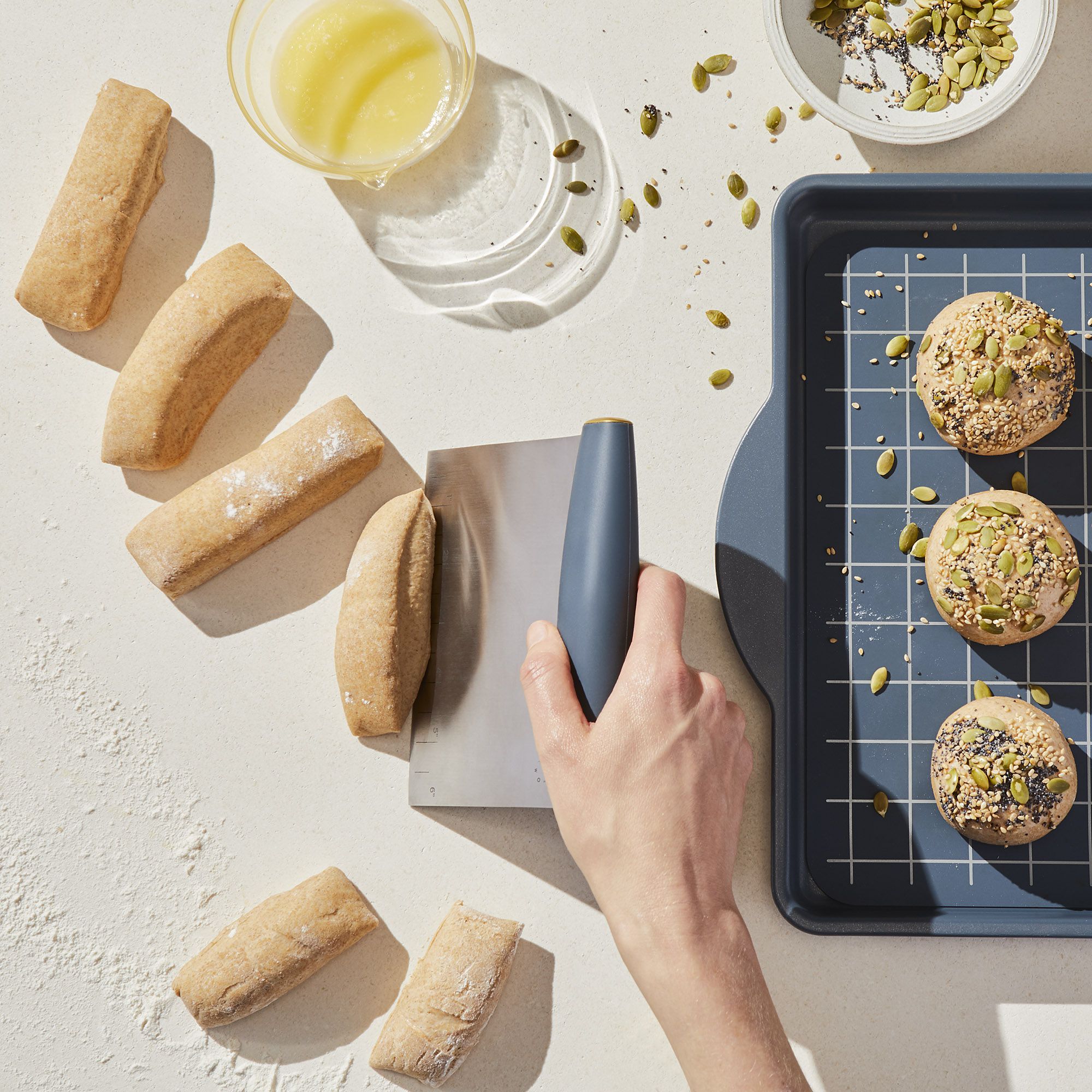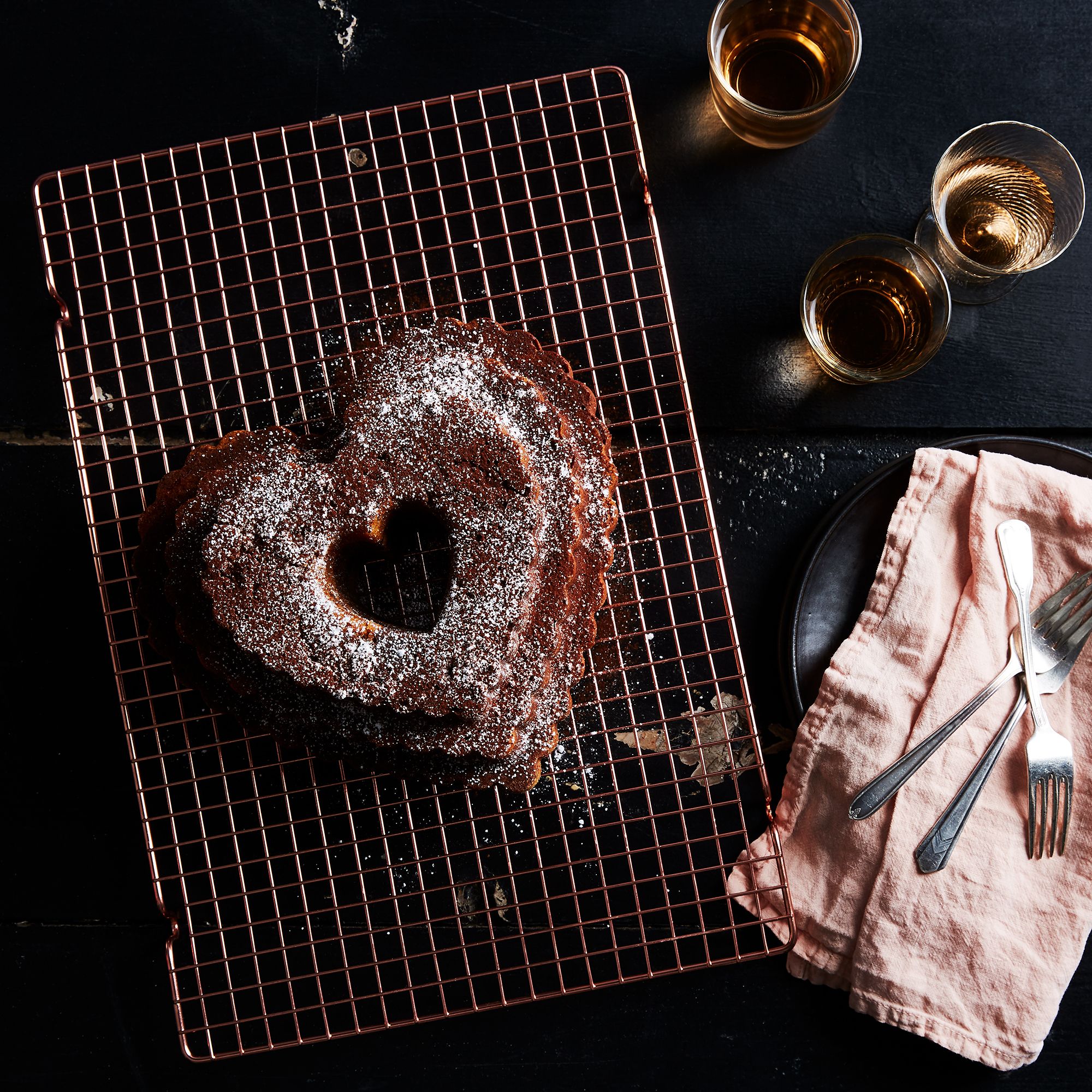There's no way around it: making pizza is hard! Take it from me—a lifelong cook from one pizza hotspot (New Haven adjacent) now living in another pizza mecca (New York City) who's eaten vast and varied slices in her hay day and still can only muster up ho-hum dough slabs in her home kitchen. It takes time, effort, and patience, and pop culture presents this notion that you have to drop everything to become a pizza maker's apprentice in Italy in order to learn all the secrets.
As alluring as that sounds, I can’t just hop on a plane tomorrow, so I did the next best thing and consulted a few NYC-based pizza pros to let me in on a few tips and tools that at-home enthusiasts need to mix, proof, bake, and slice some pretty incredible pies. Their recommendations range between simple tools like squeeze bottles and investment pieces like the Baking Steel. If you already cook and bake like clockwork, there’s a good chance you already have some of the essentials. And if you don’t, grabbing them will only strengthen your kit for all your cooking projects whether it’s artisanal pizza or rainbow cookies.
Here are 14 pizza-making tools from the pros who've perfected them.
1. Fresh, quality ingredients
Flour
When you read, you begin with the ABCs. When you make pizza dough, you begin with salt, yeast, water, and of course, flour. For Miriam Weiskind, an alum of Paulie Gee’s and the brains behind The Za Report, a pop-up speakeasy pizza concept and soon-to-be NYC’s eighth (!!) woman-owned pizzeria, it’s always been about investing in unbleached all-purpose flour and unbromated bread flour. She says you can blend the two for all types of homemade pizza, and for an authentic Sicilian? “The King Arthur bread flour will win your heart.”
Ever since the early days of making Roman-style pizza at home during the pandemic, Unregular Pizza founder Gabriele Lamonaca has sworn by Polselli's double zero flour, which is a finely-ground mix of bran and germ. “This flour is crucial if you want long maturation and pizza with a fluffy yet crunchy dough,” says Lamonaca. “I must say that it has never once disappointed me—not from a small home oven or a commercial oven.”
But of course, in the wise words of Ina Garten, store-bought is fine. Frank Tuttolomondo, owner of Mama’s Too!, suggests getting some premade dough from the grocery store or, when possible, from your local pizzeria. It's a way to get much needed context and see “how dough behaves, [how] your oven works, and [get] a feel for the tools,” says Tuttolomondo.
Canned tomatoes
Weiskind's biggest tip? “Using a can of whole peeled tomatoes and a pinch of salt, gently mill down with an immersion blender and you’ll have [professional-quality] pizza sauce just like what we use in NYC.” You can find canned tomatoes at any grocery store, though we love Bianco DiNapololi.
Melty cheese
This should go without saying, but high quality cheese is key to an exceptional pizza—just don’t think it needs to be expensive though. Christopher Ancona, director of pizza operations for Roberta’s Pizza, encourages exploring the wide world of Taleggio for solid entry-level cheese.
As someone who specializes in Neapolitan pizza, he says Taleggio is a great melter cheese “because there's only a 2-3 minute cook time, so the cheese won't split.” For pizzas with a longer cook time, add some mozzarella and heavy cream to emulsify. For good mozzarella, Weiskind likes the pre-sliced variety from BelGioioso for her home baking because “it carries less water than a [whole] ball and is ready to use for pizza night.”
Using a scale when making pizza or doing any type of baking gives you exact control over measurements. Ancona would go so far as to say, “If you're doing any cooking at all, you should own a scale.” He says to keep it simple with a basic food scale that displays whole number measurements as “fractions of a gram aren't necessary” for most, if not all, bakes.
Come time to ferment your dough, you can use any large clean bowl, tightly covered with plastic cling wrap. Or if you want to truly witness the alchemic powers of bread chemistry in action, Tuttolomondo suggests “a clear straight-edged container to give you a read on the progress of your dough bulk and fermentation, as well as a lid to keep temperature and air from getting in.” Our own food editor Emma Laperruque has also waxed poetic about why Cambro’s clear food storage container is essential for “bready situations like doughs.”

4. Bench and bowl scrapers
Another in the running for a must-have accessory is a scraper. There are two types—metal bench scrapers and flexible plastic bowl scrapers—both of which Ancona and Tuttolomondo recommend getting. You’ll go back and forth between using the two scrapers to cut and shape dough, scrape dough from mixing bowls, clean up your workstation, transfer finely-chopped herbs from the cutting board into a prep bowl, or to loosen and lift a square pizza from the pan. Scrapers tend to go missing when you need them the most, which is why Ancona always has a few backups.
5. A pizza pan
At Mama’s Too, the team uses wide and short-brimmed pans to bake their thick Sicilian square pies. Tuttolomondo suggests a 12 by 18-inch Sicilian pizza pan. For durability, he advises to “wash [the pan] when fully cooled down to avoid warping and non-stick to chip.”
In Weiskind’s kitchen, she deploys a tall Detroit-style pizza pan because it gives you the ability to make several styles [of pizza] despite the height of the pan.” Technically, you could use a 9 by 13-inch cake pan, but the benefits of a dedicated pizza pan far outweigh the perceived costs of another piece of bakeware. That’s especially true if you make a lot of pizza at home. Pizza pans are usually made of anodized aluminum, a type of nonreactive material that’s lined with non-stick coating and come pre-seasoned for immediate and frequent use. They were built to dish out pizza and her not-so-distant bread cousin, focaccia.
No matter if you prep your pizza on your countertop or a dedicated pizza peel, getting it into the oven is a battle in and of itself. All the chefs agree that a pizza peel should have three qualities: 1) a beveled tip for easy launching (the process of transferring dough from the peel into the oven), 2) a tip that easily fits through the opening of your oven, and 3) a good weight overall. Word of advice from Tuttolomondo: “Dust your peel before making pizza to avoid sticking!” He suggests sprinkling all-purpose flour or fine semolina flour. In a pinch, he says you can also launch with a wooden cutting board, which can pull double-duty when you’re ready to slice the pie.
And to dispense the gorgeous sauce across the dough, Ancona suggests using a flat bottom ladle, or spoodle (which we prefer). He uses a 2-ounce spoodle for a 12-inch pie “because they require fewer rotations around the pizza in order to spread the sauce evenly.” Working smarter and not harder, we love to eat see it.

Let me start off by saying, you can absolutely bake incredible pizzas in a standard kitchen oven. But if you're looking to take things up a notch, you might want a dedicated pizza oven. The Ooni Koda 16 is great because it’s easy to use, transports effortlessly from point A to point B, and has ample real estate for proper baking. There are wood-fire ovens, but gas-powered models are the way to go because they provide consistent results and forgo the need to get logs of wood. The Ooni is an investment, for sure, but guarantees years of amazing homemade pizzas. Plus, you can use it for any type of outdoor grilling beyond pizza.
When we set out to learn about the best pizza stone, we were surprised to discover that the pros skipped the stone entirely and went straight for The Baking Steel. Pizza aficionado and steelmaker Andris Lagsdin came up with the idea after reading “Modernist Pizza.” As Weiskind explains, “Most people think to use a [pizza] stone, which is great, but The Baking Steel retains heat much better. Because it heats evenly across the surface, you have more consistency with baking.”
Tuttolomondo is also firmly in the camp of using a baking steel especially for round pizzas. “It’s better in terms of durability and conducting heat, and [is very versatile]. Make sure to take the measurements of your oven to see which steel is good for you.”

If you notice your slices always having a floppy, unstructured crust, you might need to put on the brakes. According to Lamonaca, a cooling rack is an essential tool for homemade pies (and cakes, and cookies). “People make the mistake of serving pizza right after it's done cooking, but I think it’s very important to let it rest for 1-2 minutes on a cooling rack, so that the crust breathes and doesn’t get soggy.”
For drizzling on various oils and condiments, a squeeze bottle is a must. “We're constantly using white balsamic, honey, olive oil, and chili oil,” says Ancona. If you like thicker condiments, you might need to cut the tip yourself, which Ancona does all the time. “Just remember that you can't un-snip that tip,” he says.
Even though a zester grater will come in clutch for pizza, the versatile tool can shave everything from chocolate to truffles to whole spices. At Roberta’s, Ancona is almost never without a zester grater: “I usually have a fresh spare in my roll-up.”
When it comes time to finally slice and serve, Lamonaca says the number one quality a pizza cutter *has* to have is a high quality, durable blade. Please don't use your usual chef's knife for pizza.
This post was updated in December 2021 with new original interviews and essential pizza-making tools.
What tools do you rely on when you're making pizza at home? Share with us below!
This post contains products independently chosen (and loved) by our editors and writers. Food52 earns an affiliate commission on qualifying purchases of the products we link to.





See what other Food52 readers are saying.